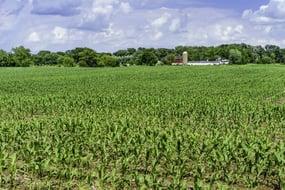In a broad sense, the Natural Resources Conservation Service (NRCS) provides landowners, farmers, and ranchers with two categories of conservation programs: working lands and easements. This post dives deeper into both categories, while part two will address how landowners and/or producers can get started in NRCS programs and why they should put their limited time and energy into the process.
“Our biggest program by dollars – the Environmental Quality Incentive Program (EQIP) – offers a wide variety of conservation practices,” said Adam Heichelbech who is the assistant state conservationist for programs for the NRCS in Indiana. “This program can help any type of farm. It’s a very broad program and different from state to state.”
Through EQIP, and the NRCS in general, landowners and/or producers can access a lot of resources to make their farms more efficient while conserving natural resources.
“EQIP helps address soil erosion, manage animal waste, improve the efficient use of nutrients, etc.,” Heichelbech explained. “This can help a producer take their conservation practices to the next level.”
In addition to EQIP, the NRCS can also help landowners enroll in the Conservation Stewardship Program (CSP). While it is the largest conservation program in the country, CSP is one of the less utilized programs in Indiana but shouldn’t be. It helps landowners and producers take their conservation system to the next level by helping producers build on their existing conservation efforts while strengthening their operation.
 In addition to financial assistance, landowners and producers have access to NRCS technical assistance which helps them get started in developing a conservation plan for the farm. Heichelbech said it’s one of their most important programs because it’s the basis for participating in most NRCS programs. It’s important to note that technical assistance is free to landowners, whether they apply for financial assistance or not.
In addition to financial assistance, landowners and producers have access to NRCS technical assistance which helps them get started in developing a conservation plan for the farm. Heichelbech said it’s one of their most important programs because it’s the basis for participating in most NRCS programs. It’s important to note that technical assistance is free to landowners, whether they apply for financial assistance or not.
For many of the programs, producers can apply for through the NRCS, a conservation plan is the first step to take. Since it’s a free service, time is the only investment a landowner or producer will make in it.
“We’ve made a big effort to prioritize conservation planning in the past few years,” Heichelbech said. “It’s really easy for someone to come into the office and say they have a gulley forming and that they need help with it. We can get them signed up for the right program to help them with it but getting a landowner or farmer to understand that we [NRCS] can come out and look at the whole farm to make sure that we help them with all the programs we possibly can is the bigger part of the challenge.”
Easements and Reserves
Protecting agricultural land is a high priority for the NRCS since it’s truly the heart and soul of the entity overall. Since easement programs were first introduced in the 90s, they’ve seen a lot of change. Most of that change benefits the landowner and/or producer.
“When easement programs first started, farmers needed to own the land for seven years before they could enroll,” Heichelbech said. “That’s gone down to two years, which has made the program available to more landowners/producers. We’re always trying to make our programs available to more and more people across the state.”
The Agricultural Conservation Easement Program’s Agricultural Land Easements (ACEP-ALE) can help protect working lands and limit non-agricultural uses of the land. The ACEP-ALE rolled the Grasslands Reserve Program (GRP) and the Farm and Ranch Land Protection Program (FRPP) all into one.
one.
Additionally, through the Agricultural Conservation Easement Program’s Wetland Reserve Easements (ACEP-WRE), NRCS provides technical and financial assistance directly to private landowners and Indian tribes to restore, protect, and enhance wetlands through the purchase of a wetland reserve easement.
“There’s not a ton of land in Indiana that’s at risk of being developed that we want to keep in agriculture, but it’s still an important program for us,” Heichelbech said. “Our bigger easement is in wetlands. That program pays landowners for the right to convert land back to wetland primarily for wildlife habitat. The landowner maintains ownership of the land so they can still technically use it.”
The Conservation Reserve Program (CRP) is administered by the Farm Service Agency (FSA), but the NRCS helps promote the program and provide technical assistance.
“Generally, CRP takes marginal land out of production for a period of time – usually ten years – to establish wildlife habitat, plant trees, grasses, etc.,” Heichelbech said. “There are potential opportunities to re-enroll that land for another ten years or it could go back into production. We encourage landowners and farmers to keep the land in the conservation sector.”
Heichelbech could talk for hours about the abounding opportunities the NRCS provides producers all across the nation. This is just a short introduction to some of the most advantageous programs for landowners and producers to investigate. Check back for part two to give you the insider tips and tricks for getting started.






